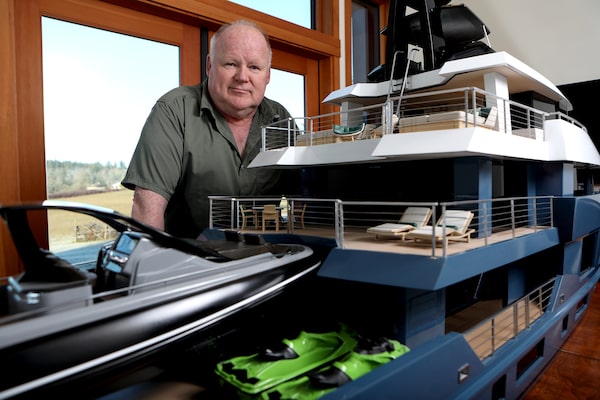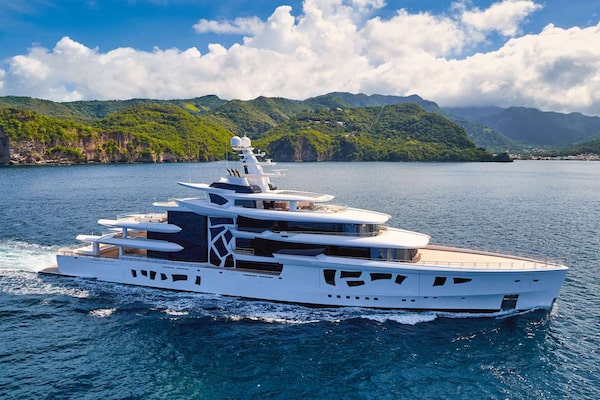The 80-metre (262-foot) motoryacht Artefact, designed by Greg C. Marshall Naval Architect, Ltd., has won numerous awards for innovation, naval architecture and interiors.Handout
Surging popularity in superyachts is driving Canadian designers and shipbuilders to push the limits of innovation and craftsmanship, redefining the opulence of life at sea in the process.
According to VesselsValue, a provider of vessel valuation and market perspective for the maritime industry, 887 superyachts – pleasure vessels larger than 24 metres (78 feet) – were sold in 2021, more than double the 429 sold in 2019.
“When I began, there were about 25 boats over a hundred feet under construction in the whole world,” says Greg Marshall, president and CEO of Gregory C. Marshall Naval Architect, Ltd. (GCMNA) in Victoria. “Now [we’re working on] that amount in our office.”
Over the past 45 years, Marshall has designed some of the most innovative and luxurious superyachts in the world including designs for Canadian builders like Neptunus Yachts in St. Catharines, Ont., and Crescent Custom Yachts in Richmond, B.C.
He suspects the big change in the volume of people buying superyachts is largely the result of improved telecommunications, which give people the ability to work anywhere – even on their boat.
“Where you are is a lot less important than it used to be,” he says. “People are used to running a billion-dollar business from their phone.”
The designs reflect that. A growing class of superyachts is blending luxury and cutting-edge technology to elevate the experience of life at sea.
“Nowadays, it doesn’t have to be the fastest boat on Earth,” says Eric Gaudette, a broker with ITA Yachts Canada, an international yacht brokerage based in Saint-Jean-sur-Richelieu, Quebec. “People are looking for comfort.”
New ways to play at sea
For some, comfort takes the shape of expansive flybridge decks – a raised platform on a yacht – with a full wet bar for entertaining. To others, it’s space for “toys” like submersibles, helicopters and car collections.
“There are now planes that land on water that you can put on the swim platform,” says Gaudette. “They’re short-range and just for fun, but the sky’s the limit.”
One of GCMNA’s recent superyacht designs is 425 feet long and carries a 70-foot yacht on the deck. “It’s got a 35-foot EarthRoamer – a two-and-a-half-million-dollar camper – on board, a couple of Teslas, a collection of Cobra cars, landing barges to take all the stuff ashore, two 10-passenger helicopters and two submarines,” says Marshall. “You just look at the toy collection on board and it’s probably $50- or $60-million.”
It’s one of several boats GCMNA has designed for this particular client (he declined to mention the owner’s name, noting that projects are referred to with four-digit codes for security reasons). “The owner names all of the boats after his dog King Benji,” says Marshall. “The first criterion [for a boat design] is that it includes a dog park for King Benji to go wander around and take a pee.”

Greg Marshall with a 10-foot-scale model of the KB6, a 45-metre (150-foot) global explorer superyacht registered in Bikini, Marshall Islands, which will be delivered to its owner in January 2024.Chad Hipolito
It’s reflective of a change in the way people are using their boats, a shift Marshall has witnessed throughout his career. In the past, yachts tended to act as a mobile wealth platform.
“If you had to move to a different country, you could move your boat with all your paintings, sculptures, fine artwork and gold,” he says. “Typically, the design of the boat was oriented toward looking inwards at your stuff.”
Recently, that’s shifted to looking outward and exploring. “It’s much more oriented toward, ‘How many electric dirt bikes can I put on there? Can I get my surfboards on the chopper? Where does my submarine go? Can I play pickleball on the roof?’” he says. “How that changes a boat’s design is [the] accommodations are reducing in size and toy storage is increasing enormously.”
Pushing the limits of innovation
Gaudette says there’s also a growing emphasis on innovating the passenger experience. He points to gyroscopic stabilization, a system which neutralizes the roll of a boat. “It kind of gets rid of the motion sickness,” says the Canadian yacht broker.
This technology is present on a lot of GMCNA-designed vessels – whether for cruising or zero-speed stabilization. Marshall says they even used the technology to design a “gyro-stabilized” dog bed for King Benji to help offset the dog’s seasickness.
There are other ways to stabilize these boats and increase passenger comfort. GMCNA is currently designing a pair of 180-foot vessels with wings that help keep it level when it’s running at faster speeds. “Our client has spent a serious amount of money – multiple millions of dollars – developing and tank-testing these foils to keep the boat level,” he says.
Alongside battery banks to offset fuel use and technology that cuts running noise down to a barely perceptible 28 decibels, the superyachts being designed and launched over the past couple of years are improving the passenger experience by reducing fuel smell and noise.
Gaudette says high-tech communication is also being incorporated. He points to Starlink, SpaceX’s satellite internet. “It’s one of the big gadgets – it’s pricey [but critical] if you want a boat that’s connected or you are going to work from your yacht.”
Marshall says he’s designed 43 boats for one client over the past 35 years, all of which the client still owns.
“He probably spends 300 days a year on board his boats,” says Marshall. “He just looks at his boats as homes now, down to having the bathroom in the same location so he doesn’t forget where to go when he wakes up in the middle of the night.”
And that client isn’t an anomaly. Alongside a surge in superyachts is an affluential younger generation raised in a world of mobility. “We’ve got three customers 30 years or younger that we’re doing 250-foot boats for,” says Marshall. “For them, they have never known not being portable.”
To Marshall, the height of luxury is freedom and superyachts exemplify that.
“It’s all about playing all day long,” he says. “Then somewhere, buried in the boat, is a three-star Michelin chef that will make you a great meal in between.”
Credit: Source link
